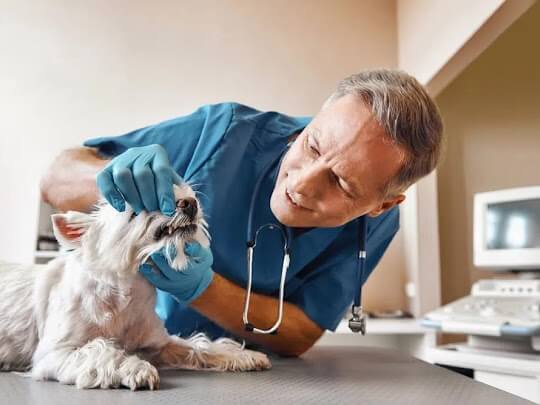Smelly breath in dogs is not normal, despite at least 80% of dogs developing some form of periodontal disease as they age. Dental health plays a massive part in your pet’s overall health, so it’s essential to keep their teeth healthy too.
While smelly dog breath might be unpleasant, it isn’t the only sign that your dog’s teeth may need looking at. If you believe that your dog may be developing signs of dental disease, but you’re not too sure what to watch out for, we can help. Take a look here at the signs and treatments of dental disease in dogs.

What dental disease can dogs get?
Signs of dental disease
- Smelly breath – Bad breath is often a strong indicator of something wrong with your dog’s teeth. Bad breath or halitosis can indicate rotting teeth or a substantial buildup of plaque and tartar.
- Red or inflamed gums – Inflamed gums are a sign that periodontal disease is in its advanced stages. Your dog’s gums are going to be red, sore and swollen, leading to a loss of appetite or reluctance to eat.
- Loss of appetite or reluctance to eat – Anyone with a dog will know that a loss of appetite is sure to indicate something is wrong. If your dog is showing symptoms of having trouble eating or they’re reluctant to eat, they may be experiencing pain from dental disease.
- Pawing at the mouth – If your dog is excessively pawing at their mouth, they may be experiencing dental pain.
- The buildup of plaque and tartar on teeth – Plaque and tartar buildup will present as discoloured stains on your dog’s teeth. Your dog’s teeth should be pearly white.
- Broken teeth – Dogs have nerves in their teeth, just like we do. A broken tooth will be incredibly painful and will need to be assessed by your vet. Broken teeth left unattended can often lead to rotting and decay that can cause serious dental problems down the road.
If you notice your dog displaying any of these signs, it’s a good idea to book in for a vet visit. Dental disease can be incredibly painful and can lead to reduced quality of life for your dog.
Treatments of dental disease in dogs
Give us a call to get your beloved furry friends booked in for their dental consultation at our veterinary clinic in Coffs Harbour, Woolgoolga or Nambucca Heads today.



